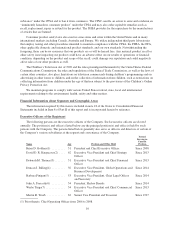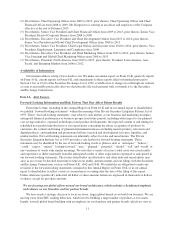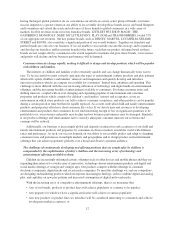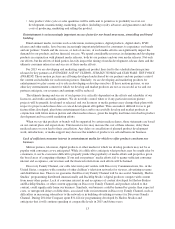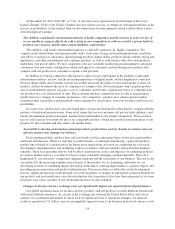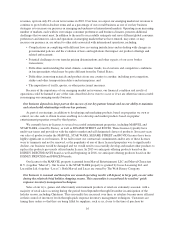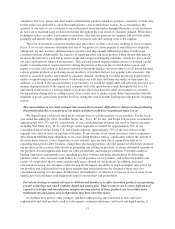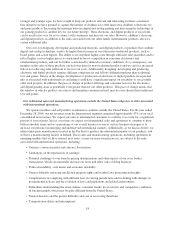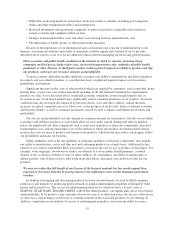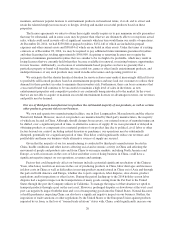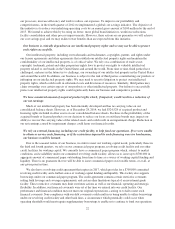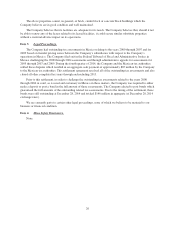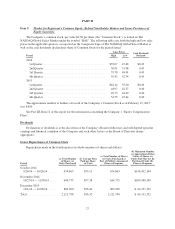Hasbro 2014 Annual Report Download - page 31
Download and view the complete annual report
Please find page 31 of the 2014 Hasbro annual report below. You can navigate through the pages in the report by either clicking on the pages listed below, or by using the keyword search tool below to find specific information within the annual report.consumers. For toys, games and other family entertainment products which we produce, a majority of retail sales
for the entire year generally occur in the fourth quarter, close to the holiday season. As a consequence, the
majority of our sales to our customers occur in the period from September through December, as our customers
do not want to maintain large on-hand inventories throughout the year ahead of consumer demand. While these
techniques reduce a retailer’s investment in inventory, they increase pressure on suppliers like us to fill orders
promptly and thereby shift a significant portion of inventory risk and carrying costs to the supplier.
The level of inventory carried by retailers may also reduce or delay retail sales resulting in lower revenues
for us. If we or our customers determine that one of our products is more popular at retail than was originally
anticipated, we may not have sufficient time to produce and ship enough additional products to fully meet
consumer demand. Additionally, the logistics of supplying more and more product within shorter time periods
increases the risk that we will fail to achieve tight and compressed shipping schedules, which also may reduce
our sales and harm our financial performance. This seasonal pattern requires significant use of working capital,
mainly to manufacture or acquire inventory during the portion of the year prior to the holiday season, and
requires accurate forecasting of demand for products during the holiday season in order to avoid losing potential
sales of popular products or producing excess inventory of products that are less popular with consumers. Our
failure to accurately predict and respond to consumer demand, resulting in our under producing popular items
and/or overproducing less popular items, would reduce our total sales and harm our results of operations. In
addition, as a result of the seasonal nature of our business, we would be significantly and adversely affected, in a
manner disproportionate to the impact on a company with sales spread more evenly throughout the year, by
unforeseen events such as a terrorist attack or economic shock that harm the retail environment or consumer
buying patterns during our key selling season, or by events such as strikes or port delays that interfere with the
shipment of goods, particularly from the Far East, during the critical months leading up to the holiday shopping
season.
The concentration of our retail customer base means that economic difficulties or changes in the purchasing
or promotional policies or patterns of our major customers could have a significant impact on us.
We depend upon a relatively small retail customer base to sell the majority of our products. For the fiscal
year ended December 28, 2014, Wal-Mart Stores, Inc., Toys “R” Us, Inc. and Target Corporation, accounted for
approximately 16%, 9% and 8%, respectively, of our consolidated net revenues and our five largest customers,
including Wal-Mart, Toys “R” Us and Target, in the aggregate accounted for approximately 38% of our
consolidated net revenues. In the U.S. and Canada segment, approximately 59% of the net revenues of the
segment were derived from our top three customers. If one or more of our major customers were to experience
difficulties in fulfilling their obligations to us, cease doing business with us, significantly reduce the amount of
their purchases from us, favor competitors or new entrants, increase their direct competition with us by
expanding their private-label business, change their purchasing patterns, alter the manner in which they promote
our products or the resources they devote to promoting and selling our products, or return substantial amounts of
our products, it could significantly harm our sales, profitability and financial condition. Customers make no
binding long-term commitments to us regarding purchase volumes and make all purchases by delivering
purchase orders. Any customer could reduce its overall purchase of our products, and reduce the number and
variety of our products that it carries and the shelf space allotted for our products. In addition, increased
concentration among our customers could also negatively impact our ability to negotiate higher sales prices for
our products and could result in lower gross margins than would otherwise be obtained if there were less
consolidation among our customers. Furthermore, the bankruptcy or other lack of success of one or more of our
significant retail customers could negatively impact our revenues and profitability.
Part of our strategy to remain relevant to children and families is to offer innovative products incorporating
greater technology and which combine digital and analog play. These products can be more difficult and
expensive to design and manufacture, margins on some portion of these products are lower than more
traditional toys and games and such products may have short life spans.
As children have grown “older younger” and have otherwise become interested in more and more
sophisticated and adult products, such as video games, consumer electronics and social and digital media, at
17





